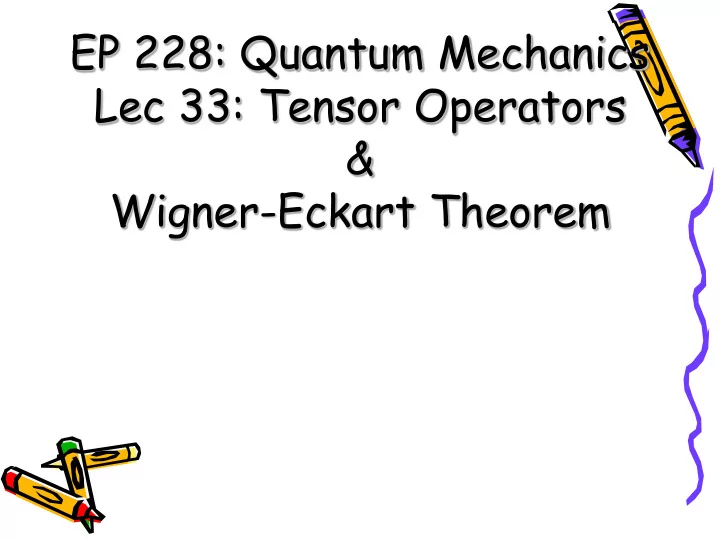

EP 228: Quantum Mechanics Lec 33: Tensor Operators & Wigner-Eckart Theorem
Recap: CG coeffts for addn of two spin 1/2 • Uncoupled basis • Maximum m=1 and s=j max = 1. Hence this coupled state
Recap:CG coeffts for addn of two spin ½ contd • m = 0 can be obtained by acting lowering operator on LHS and RHS of • Recall , • LHS:
Recap:CG coeffts for addn of two spin ½ contd • Action of lowering operator on RHS of • = • Recall LHS . • Equating •
Recap: CG coeffts for addn of two spin ½ contd • Acting lowering operator on LHS and RHS of • What will we get? • Check whether you get this • How to determine
Recap: CG coeffts for addn of two spin ½ contd • The state must be orthogonal to • , , • In particular, m=0 state requires the same uncoupled basis. Hence, • Now we will look at tensor operators
Scalar operators • Under rotation, we know how state vectors transform. How will linear operator A transform? A A ’ = U † ( θ ) A U( θ ) • • When do we call a operator scalar? • Scalar do not change under rotations • From the similarity transformation, we can conclude that all scalar operators will commute with angular momentum operators [A, J i ] =0 We know components of a vector transform like • like the position vector components under rotations.
Vector operators • Under rotation, we know how state vectors transform. How will linear operator A transform? A A ’ = U † ( θ ) A U( θ ) • • We know components of a vector transform like the position vector components under rotations . • What is the commutator of [J i , r j ]? • The same holds for any vector operators- • Examples: position vector, linear momentum, angular momentum, vector potential etc • Examples of scalar operators: dot product of two like ( r.p ) , radial component r= √( r.r)
Irreducible spherical Tensor operators • We denote T(k,q) as irreducible tensor operator of rank k where q takes – k,- k+1,….+k • Scalar operator will be T(0,0). • Vector operator will be T(1,q) where q can be 1,0,-1. • Position vector {-iy± (- x)}/√2=T(1, ±1), z=T(1,0) • We can check [ J z , T(k,q)] = qT(k,q) • [J±, T(k,q)]=?
Irreducible spherical Tensors like Spherical harmonics
Irreducible spherical Tensor operators • T(k,q) irreducible tensor operator of rank k where q takes – k,- k+1,….+k resembles state vector|k,q> • Just like we take tensor product of states |k 1 , q 1 > |k 2 , q 2 > giving uncoupled basis, we can take tensor product of two irreducible tensors giving reducible tensor
ReducibleTensor operators • We can take tensor product of two vectors – for example moment of inertia tensor I ij (reducible). How many components does this have? • This has 9 components (like uncoupled basis) • We can break it three pieces (like coupled basis): (i) trace of I (behaves like scalar k=0) (ii) antisymmetric matrix I (behaves like vect k=1) (iii) symmetric traceless matrix I- how many components does this have? Recall |1, q 1 > |1,q 2 > is 9 diml LVS. The coupled basis |j,q> will allow j=0,1,2
Commutator with angular mom
Irreducible spherical tensor operators • Using the same CG coeffts, we can divide the tensor product of two vectors. • A(k, q) B(r,s ) = ∑ CG T( a,q+s) where a is an element of angular momentum addition k + r. • (i) trace of I (behaves like scalar k=0) • (ii) antisymmetric matrix I (behaves like vector k=1) • (iii) symmetric traceless matrix I( behaves like rank 2 tensor with 5 components)
Wigner- Eckart Theorem • Selection rule for matrix elements of spherical tensor operators T(k,q) where states are angular momentum states |j,m> • < j’,m’|T (k,q)|j,m > = <j’||T(k)||j> < j,k; m,q| j’,m’> • RHS has two terms: first term is dynamical term called reduced matrix element(needs experimental data) 2 nd term is geometrical dependent on orientation given by CG coefft
Wigner- Eckart Theorem • < j’,m’|T (k,q)|j,m > = <j’||T(k)||j> < j,k; m,q| j’,m’> • Using the above theorem, we can see that matrix elements of scalar operators must be only diagonal(non-diagonal terms is zero) • Given matrix elements for z-component of a vector operator, can we obtain x-component of the vector operator? • Yes. Using CG coeffts, we can write the answer • Quadrapole moment tensor is rank 2 tensor?
Applications in nuclear physics • Protons, neutrons and other particles have isospin I satisfy algebra like angular momentum J • Isopin does not interact with angular momentum. • Rotational invariance requires any scattering process or decay process to obey angular momentum conservation • In strong nuclear interactions, scattering • process and decay process conserve • isospin.
Applications in nuclear physics • Using Wigner-Eckart theorem, the ratios of scattering amplitudes or decay rates can be computed for strong nuclear process. • Determine the ratio of the decay rates of rho meson and Pi meson whose I=1:
Hope you enjoyed the semester
Recommend
More recommend